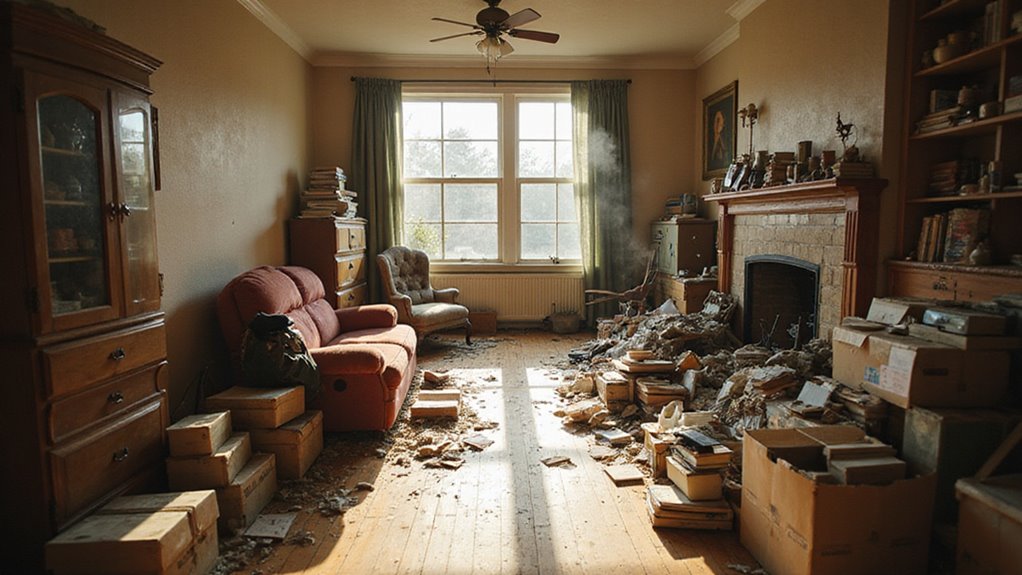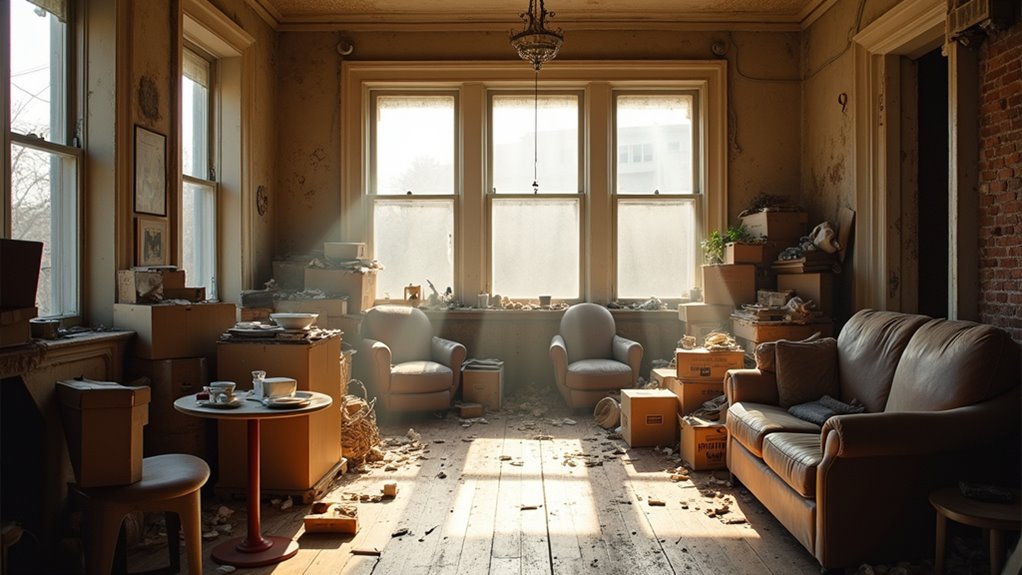Selling a hoarder house can feel overwhelming. Most buyers see clutter and problems, not potential. Homeowners often fear low offers and long wait times.
The mess and damage turn away regular buyers. Stigma and safety concerns add even more stress. Owners worry about losing money or getting stuck with the property. To market a hoarder house for sale, you must target investors and highlight its potential value.
Focus on honest ads, clear photos, and selling to the right audience. These steps can help you sell faster and for a better price. This blog will guide you through proven strategies to market and sell a hoarder house successfully.
Key Takeaways
- Target investors, flippers, and buyers seeking affordable homes with renovation potential.
- Clearly disclose the property’s condition and any repairs needed in all marketing materials.
- Use honest before-and-after photos and video walkthroughs to highlight improvements and showcase potential.
- Highlight unique features, local amenities, and the home’s value as a rare opportunity.
- Work with experienced agents skilled in marketing and negotiating distressed or hoarder properties.
Understanding the Unique Challenges of Hoarder Properties

Hoarder properties have unique challenges that are different from other distressed homes. These homes often have excessive clutter, bad smells, and blocked spaces. If not addressed, these issues can make the home hard to sell. Violations related to building code compliance are also common in hoarder homes, as hidden damage, unauthorized repairs, or safety hazards may be present and require legal attention during the sale process.
Hoarding can also hide bigger problems like pests or damage to the house. The National Association of Professional Organizers says hoarder homes may have three to five times more items than normal. This can affect how rooms feel and work.
If you want to sell a hoarder property, highlight its potential for improvement. Buyers may be interested if you show how the home can regain balance and better design. Focusing on these areas can help your listing stand out.
It’s also important to understand the disclosure requirements when selling a hoarder house, as failing to inform buyers of hidden damage or hazards can lead to legal trouble.
Assessing the Condition of the Home
Start by thoroughly identifying any structural concerns, as these can significantly impact value and buyer interest. Evaluate cleanliness levels to gauge the scope of work needed and set realistic expectations. Note all safety hazards, since addressing them upfront can reduce liability and streamline the sales process.
Additionally, it’s important to check for any property liens that could block or delay the sale, so you can address these legal issues early in the marketing process. Well-maintained homes generally sell faster and are more appealing to buyers looking for quick closings.
Identifying Structural Concerns
To market a hoarder house, you must check its structure for hidden damage. Clutter often hides problems like mold, rot, or cracks. Removing clutter lets you see and inspect all areas clearly.
Walls, floors, and ceilings should be checked after decluttering. Attics and basements may have leaks or pests if left unchecked. If you find damage, call a licensed inspector for a full report.
Inspectors can suggest what repairs are needed. If you use storage solutions during cleanup, you can help prevent future hoarding. Clear spaces and documented repairs make buyers more confident and raise the home’s value.
Evaluating Cleanliness Levels
To evaluate cleanliness levels, check each room for dirt, smells, stains, and clutter. A clean home creates a strong first impression for buyers. If the house is messy, buyers may lose interest quickly.
You should walk through every room and look for visible dirt or lingering odors. Kitchens, bathrooms, and entryways often need the most attention. If you notice clutter, remove it right away.
Studies show that clean homes sell faster and for more money. You can take photos and notes to record problem areas. This documentation helps you manage cleaning tasks and track your progress.
If you create a cleaning schedule, you can make sure no area is missed. Prioritizing high-traffic spots improves the home’s appeal. These steps will help you get the house ready to sell.
Noting Safety Hazards
When checking a hoarder house, you must spot any safety hazards right away. Safety issues can stop buyers or slow down a sale. Common hazards include blocked exits, bad wiring, and weak floors caused by too much clutter.
The National Fire Protection Association says clutter raises fire risk and blocks emergency help. Clear hallways and make sure all doors and windows open easily. Remove piles that block escape routes.
Look for biohazards such as mold or pests. These hazards can harm the home and the health of buyers. If you find these problems, take steps to fix them.
If occupants are present, offer them support during cleanup. Addressing safety issues can be stressful for them. If you handle these hazards, you make the home safer and more appealing to buyers.
Deciding on Cleaning Versus Selling As-Is
Deciding whether to clean or sell a hoarder house as-is depends on your goals and resources. Cleaning usually helps homes sell faster and for more money. Selling as-is can save time and effort but may mean a lower price.
Cleaned homes usually sell 30% faster and for up to 25% more. Cleaning costs money and takes time, so plan carefully. If you decide to clean, using storage solutions can make the home look bigger and neater. Sellers who choose to clean should be aware that market conditions such as high interest rates or supply chain issues can also impact sale price and buyer expectations.
If you cannot clean due to cost or emotional reasons, selling as-is is a valid option. Investors and cash buyers often buy homes in any condition. Local market trends can help you decide which choice is best.
You should compare the possible extra profit from cleaning with the quick sale of selling as-is. Always consider your budget, timeline, and emotional comfort. This will help you choose the best strategy for your situation. Looking at comparable sales data in your local market can also help you better understand how much cleaning may impact your sale price.
Working With Professional Cleaners and Organizers

Hiring professional cleaners and organizers makes a hoarder house easier to sell. These experts can remove hazards like mold, pests, or dangerous waste. Cleaned homes often sell faster and for more money than cluttered ones.
Insurance companies may refuse to cover homes with too much clutter or hazards. If you use professional services, you help the property meet lender and insurer standards. This step also creates a safer environment for buyers. Because structural safety concerns can deter buyers and jeopardize deals, addressing cleanliness and hazards early supports better market performance.
Working with professionals can make the selling process smoother. Sellers may face less legal risk if cleaning is done properly. A well-presented home can lead to better negotiation outcomes with buyers. Adding thorough cleaning and decluttering can improve the home’s appeal, increase brightness, and create a more inviting atmosphere for potential buyers.
Addressing Health and Safety Concerns
Hoarder homes often have mold, pests, or damage that can cause health and safety problems. You must fix these issues before selling. If you skip this step, buyers may lose interest and property value can drop.
First, remove any items that block access or may be contaminated. If there is strong emotional attachment, consider getting help from a counselor or mediator. This can make the process easier for everyone involved.
It’s also important to use protective gear such as masks and gloves during the cleaning to guard against exposure to mold, dust, or pests. Start by clearing out blocked or contaminated items, and seek support if emotional attachment makes the process difficult.
Next, hire licensed inspectors to check for hidden hazards. Use certified contractors to fix any problems they find. Always document repairs and cleaning for transparency.
If you address these issues early, your property will meet safety rules. It will also be more appealing to buyers. Buyers want to know the home is safe and clean. If you want to avoid doing repairs yourself, you can consider selling to a company that buys houses as-is, which eliminates the need for costly renovations and guarantees a fast, cash closing.
Obtaining Accurate Property Valuations

You need a precise property valuation to set a competitive price and attract serious buyers. Retained contents can obscure a home’s true condition, often lowering appraised value by 5–30% compared to similar cleared properties. Work with professionals experienced in hoarder homes to ensure you’re accounting for all factors that impact market value.
Re-listing with fresh marketing efforts and data-driven price adjustments can help rebuild buyer confidence and counteract stigma from long market exposure. Be sure to also document any known structural damage or mold issues, as required by Virginia law, to maintain transparency and minimize legal risk during the sale process.
Assessing True Property Value
A true property value is the fair market price of your home. An accurate valuation is key for setting the right price. This is especially important for a hoarder house.
A local real estate appraiser can give you a reliable estimate. Choose someone who knows how to value distressed homes. If you rely only on online tools, you might get an inaccurate number.
You should compare recent sales of similar homes nearby. Adjust the price for your house’s current condition. This helps you avoid overpricing or underpricing.
If the house can be staged, it may help buyers see its value. Professional staging often increases the home’s appeal. Listing your property at the right time can also help you get a better price.
Use facts and local data to guide your decisions. A careful approach positions your property well in the market. This helps you reach the best possible outcome.
Impact of Contents Retention
The value of a property can drop if it is full of personal belongings. Buyers and appraisers may find it hard to see the real size and condition. If the house is crowded, it may lead to lower offers or slow sales.
Hidden damage often goes unnoticed when clutter covers walls and floors. If you hire professionals to clean out, you can reveal the true state of the property. Removing clutter from blocked areas also helps buyers and appraisers inspect the home fully.
Skewed appraisals happen if rooms are not organized before valuation. If you organize and tidy up, the appraiser can give a fairer value. Transparent disclosure about the property’s condition increases buyer confidence and trust.
Disclosing Property Conditions Legally
State and federal laws require sellers to share all important property conditions. If a home has hoarding-related problems, these must be shared.
Sellers need to provide a detailed disclosure before listing the home. Sellers are legally required to disclose any hoarding-related issues or major property conditions before listing a home.
A disclosure statement should mention issues like structural damage, pests, or mold. Hoarder homes often have these problems. If these conditions exist, they must be honestly reported. In Virginia, legal disclosure requirements specifically obligate sellers to inform buyers about known defects including structural issues, water damage, or infestations.
A 2023 survey showed 87% of buyers want full disclosure. Honest documentation can protect sellers from legal trouble. It also helps build trust with buyers.
Pairing your disclosure with home staging and market analysis can help. These steps show buyers you are serious and realistic. Honest details make the sale process smoother and reduce problems after the sale.
If your home is at risk of foreclosure, acting quickly to disclose all property issues and engage with professionals can help protect your financial future and ensure a smoother sale.
Targeting the Right Buyer Demographic

Targeting the right buyer demographic means finding people who see value in a hoarder property. These buyers often include investors, flippers, and those looking for affordable homes. They care more about location and potential than current clutter.
If you highlight strong community features, you may attract 30% of distressed property buyers. Many look for neighborhoods with active communities, believing they can improve the area. Mentioning nearby luxury amenities like parks or gyms can make the property more appealing.
You should focus marketing on investors, renovation experts, and first-time buyers. These groups often search for homes with potential or lower prices. If you understand their needs and promote local resources, you increase your chances of getting offers. Marketing specifically to buyers who purchase homes as-is can save sellers time and money by eliminating the need for repairs and offering fast closings.
Creating Honest and Compelling Listings
To create an honest and appealing listing, present the home’s condition clearly. Buyers want transparency and appreciate knowing about any problems. If you are open, buyers are more likely to trust your listing.
Include recent, accurate photos that show all parts of the house. If possible, mention any areas that need work. A clear description should state the home’s condition without hiding issues. Use clear, up-to-date photos and describe any needed repairs so buyers understand the true condition of the home.
Highlight the property’s best features, such as a large yard or special design. If the home has unique elements, mention them. Strong points can attract buyers, even if the house needs repairs.
Use positive and descriptive language to show the home’s potential. If you position it as a rare find, more people may be interested. Engaging photos and honest words can help your listing stand out.
Highlighting Investment and Renovation Potential

Many buyers look past clutter and needed repairs if they see a chance for a good investment. Renovating a hoarder house can greatly increase its value. If buyers want to upgrade kitchens, bathrooms, or add smart features, the resale price can rise.
NAR reports that homes with clear renovation potential can sell for up to 20% more. This is especially true if there are few homes for sale in the area. Investors often look for homes they can improve and sell for a profit.
Sellers should show buyers the possible changes with cost estimates and likely resale values. The home can be called a blank canvas for those who want to build equity or create a custom look. If buyers know the costs and rewards, they are more likely to take on the project.
Utilizing Before-and-After Visuals
You should use before-and-after visuals to clearly showcase the transformation progress of a hoarder house. Studies show that buyers are 67% more likely to trust listings that demonstrate real improvement. By presenting these visuals, you’ll build buyer confidence and set your property apart from others on the market.
Highlighting Transformation Progress
Showing before-and-after photos is the best way to prove a hoarder house has changed. These images help buyers see the real improvements. If buyers see progress, they may feel more confident about the property.
Before-and-after photos should focus on main rooms and entryways. Captions should point out important changes after clutter is cleared. If you use a visual timeline, buyers can follow the steps taken.
Short video walkthroughs can also highlight how each room now works. Listings with transformation photos can get up to 60% more online views. If you want buyers to notice progress, clear visuals are essential.
Building Buyer Confidence
Clear before-and-after photos help buyers trust your listing. These images show that you have fixed the property’s main problems. Buyers can see improvements, which makes them feel more comfortable.
Staged homes are easier for buyers to imagine as their own, according to the National Association of Realtors. If you add staging to your photos, buyers can better see the home’s potential. This increases the chance they will make an offer.
If you share these visuals in listings and community groups, more people will notice your property. When buyers see real changes, they often feel more confident. This can make them less hesitant and raise your home’s value.
Choosing the Right Real Estate Agent
Selling a hoarder house requires a real estate agent with the right experience. The agent should understand hoarder properties and the challenges involved. If you choose wisely, you can sell your home faster and for a better price.
Look for agents who have sold hoarder or distressed houses before. They should show proof of past success in similar sales. If they have this experience, they are more likely to help you.
A good agent will have a strong network of helpers. They should know people who can help with storage or donations. This support can make decluttering easier.
Ask each agent about their marketing plan for tough properties. If they use proven strategies, they can attract serious buyers. The right approach can make your home stand out.
Choose an agent who communicates clearly and often. You need someone who explains each step and offers real solutions. If you feel informed, you can make better decisions.
Negotiating Offers and Handling Buyer Concerns
When you get offers on a hoarder house, buyers may worry about the home’s condition and cleanup costs. You should respond clearly with facts about similar local sales. If you have staged the home, mention it to show you are improving its appeal.
Sellers can address buyer concerns by being honest about the home’s issues and its potential. Present community information to show the area is stable and valuable. Buyers may feel more confident if you share neighborhood strengths.
If buyers worry about cleanup costs, offer credits at closing. You can also provide contractor bids for repairs if needed. This often helps speed up negotiations.
Some buyers may have trouble getting financing. In that case, suggest lenders who are familiar with such properties. Doing so can increase the chances of a successful sale.
Streamlining the Sales Process for a Smooth Transaction
To ensure a seamless sale, you need clear communication with buyers, efficient documentation preparation, and flexible showings. Studies show that transparent updates and quick response times can cut transaction delays by up to 30%. By streamlining these steps, you’ll build buyer trust and move the process forward without unnecessary setbacks.
Clear Communication With Buyers
Clear communication with buyers is important when selling a hoarder house. It helps prevent misunderstandings and builds trust. If you are open with buyers, you can avoid surprises that might stop the sale.
You should always disclose the property’s condition. Show before-and-after photos if junk removal was done. Buyers should know about any major cleaning or repairs.
Explain all actions taken to improve the house. List any emotional support given to the previous owner. This can help buyers understand the situation better.
Set realistic expectations about showings and inspections. Buyers should know what to expect during their visit. If you are honest, buyers are more likely to stay interested.
Respond quickly to any buyer questions. Prompt answers keep negotiations moving. If you communicate well, the sale process will be smoother.
Efficient Documentation Preparation
Efficient documentation is key for a fast hoarder house sale. You should gather all important documents before listing the property. These include property disclosures, repair records, inspection reports, and floor plans.
Buyers want to see clear proof of any improvements. If you made changes to the interior or improved feng shui, document them. Before-and-after photos can help show upgrades like decluttered rooms or better layout.
Digital files make sharing easy if you want to speed up the process. If you keep all paperwork organized, buyers will feel more confident. Complete documentation can prevent delays and help your sale close faster.
Coordinating Flexible Showings
Flexible showings make it easier for buyers to visit a property. This increases the chances of selling, especially for hoarder homes. If buyers can see the home easily, they are more likely to make an offer.
You can offer longer viewing hours to fit different schedules. Staging important rooms helps buyers see storage possibilities. If showings are scheduled one at a time, both buyers and sellers feel less stress.
Some buyers or sellers may feel overwhelmed. If this happens, you should provide emotional support and helpful resources. This strategy helps buyers decide faster and makes the selling process smoother.
Conclusion
If you want to sell a hoarder house, you should focus on honesty and highlight the home’s potential. If you present the property’s possibilities, you attract buyers who see value beyond the clutter. When you target the right audience, your chances of a quick sale increase.
If you prefer a fast and stress-free process, you can consider selling your house for cash. We buy houses for cash, so you do not need to worry about cleaning or repairs. If you choose this route, you can sell your property as-is and close quickly.
If you are ready to take the next step, let us help. We at Align Real Estate Solutions are here to make selling your hoarder house easy. Contact us today to get started and receive a fair cash offer.
Author
-

Zach Koops is co-founder and Real Estate Success Manager at Align Real Estate Solutions, serving homeowners across Virginia since 2024. With a passion for real estate and a heart for people, Zach has built his career around helping sellers navigate tough situations—foreclosure, inheritance, relocation, repair-overload—with clarity and compassion. He’s known for being straightforward, steady under pressure, and deeply invested in relationships. Outside of work, he spends his time as a husband and father, enjoys the outdoors in Shenandoah Valley, loves singing on stage, and constantly seeks growth through reading and new experiences.









